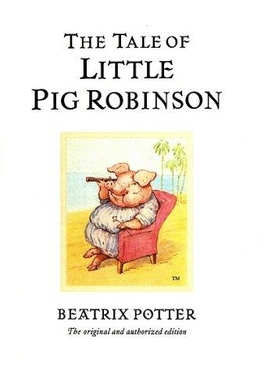The Tale of Little Pig Robinson
The Tale of Little Pig Robinson is a children's book written and illustrated by Beatrix Potter, and first published in 1930. It is one of the last books in Potter's series of Peter Rabbit and friends, and it shares the gentle, detailed narrative and illustration style that characterizes her work. The story is set in the fictional land of the "Big Pond," a vividly realized English seaside.
Plot[edit | edit source]
The narrative follows the adventures of Little Pig Robinson, a young pig who lives with his aunts, Miss Porcas and Miss Dorcas. Sent to market to sell produce from their farm, Robinson encounters a series of misadventures that lead him to be kidnapped by sailors. The tale unfolds with Robinson's journey at sea and his eventual arrival at the "Island of the Bong tree," a reference to Edward Lear's poem "The Owl and the Pussycat." Throughout his journey, Robinson demonstrates cleverness and bravery, ultimately securing a happy life on the island.
Themes and Analysis[edit | edit source]
The story explores themes of adventure, independence, and the search for a better life. Potter's detailed illustrations and narrative style bring to life the Victorian-era seaside and maritime culture, reflecting her love for the English countryside and her keen observation of nature and animals. The tale also touches on the idea of resilience in the face of unexpected challenges, a common theme in Potter's works.
Publication History[edit | edit source]
"The Tale of Little Pig Robinson" was written towards the end of Potter's career. It was intended to be part of a larger collection of tales, but due to various circumstances, including Potter's declining health and the onset of World War II, it was one of her last published works. The story is notable for drawing on Potter's childhood memories and her travels to the seaside, making it a deeply personal work.
Reception[edit | edit source]
Upon its release, the book received positive reviews for its charming story and detailed illustrations. It has since been regarded as a classic of children's literature, celebrated for its warmth, humor, and the quality of its illustrations. Like Potter's other works, it has been reprinted multiple times and translated into several languages.
Legacy[edit | edit source]
"The Tale of Little Pig Robinson" holds a special place in the canon of British children's literature. It exemplifies Beatrix Potter's contributions to the genre, showcasing her skill as a storyteller and an illustrator. The book has inspired adaptations and references in other media, contributing to the enduring popularity of Potter's characters and stories.
This article is a literature-related stub. You can help WikiMD by expanding it!
Search WikiMD
Ad.Tired of being Overweight? Try W8MD's physician weight loss program.
Semaglutide (Ozempic / Wegovy and Tirzepatide (Mounjaro / Zepbound) available.
Advertise on WikiMD
|
WikiMD's Wellness Encyclopedia |
| Let Food Be Thy Medicine Medicine Thy Food - Hippocrates |
Translate this page: - East Asian
中文,
日本,
한국어,
South Asian
हिन्दी,
தமிழ்,
తెలుగు,
Urdu,
ಕನ್ನಡ,
Southeast Asian
Indonesian,
Vietnamese,
Thai,
မြန်မာဘာသာ,
বাংলা
European
español,
Deutsch,
français,
Greek,
português do Brasil,
polski,
română,
русский,
Nederlands,
norsk,
svenska,
suomi,
Italian
Middle Eastern & African
عربى,
Turkish,
Persian,
Hebrew,
Afrikaans,
isiZulu,
Kiswahili,
Other
Bulgarian,
Hungarian,
Czech,
Swedish,
മലയാളം,
मराठी,
ਪੰਜਾਬੀ,
ગુજરાતી,
Portuguese,
Ukrainian
Medical Disclaimer: WikiMD is not a substitute for professional medical advice. The information on WikiMD is provided as an information resource only, may be incorrect, outdated or misleading, and is not to be used or relied on for any diagnostic or treatment purposes. Please consult your health care provider before making any healthcare decisions or for guidance about a specific medical condition. WikiMD expressly disclaims responsibility, and shall have no liability, for any damages, loss, injury, or liability whatsoever suffered as a result of your reliance on the information contained in this site. By visiting this site you agree to the foregoing terms and conditions, which may from time to time be changed or supplemented by WikiMD. If you do not agree to the foregoing terms and conditions, you should not enter or use this site. See full disclaimer.
Credits:Most images are courtesy of Wikimedia commons, and templates, categories Wikipedia, licensed under CC BY SA or similar.
Contributors: Prab R. Tumpati, MD

